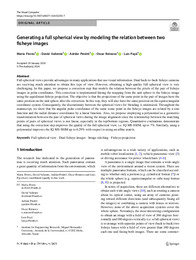Por favor, use este identificador para citar o enlazar este ítem:
https://hdl.handle.net/11000/32913Registro completo de metadatos
| Campo DC | Valor | Lengua/Idioma |
|---|---|---|
| dc.contributor.author | Flores, María | - |
| dc.contributor.author | Valiente, David | - |
| dc.contributor.author | Peidró, Adrián | - |
| dc.contributor.author | Reinoso, Óscar | - |
| dc.contributor.author | Paya, Luis | - |
| dc.contributor.other | Departamentos de la UMH::Ingeniería de Sistemas y Automática | es_ES |
| dc.date.accessioned | 2024-09-03T12:50:05Z | - |
| dc.date.available | 2024-09-03T12:50:05Z | - |
| dc.date.created | 2024 | - |
| dc.identifier.citation | The Visual Computer, 2024 | es_ES |
| dc.identifier.uri | https://hdl.handle.net/11000/32913 | - |
| dc.description.abstract | Full spherical views provide advantages in many applications that use visual information. Dual back-to-back fisheye cameras are receiving much attention to obtain this type of view. However, obtaining a high-quality full spherical view is very challenging. In this paper, we propose a correction step that models the relation between the pixels of the pair of fisheye images in polar coordinates. This correction is implemented during the mapping from the unit sphere to the fisheye image using the equidistant fisheye projection. The objective is that the projections of the same point in the pair of images have the same position on the unit sphere after the correction. In this way, they will also have the same position on the equirectangular coordinate system. Consequently, the discontinuity between the spherical views for blending is minimized. Throughout the manuscript, we show that the angular polar coordinates of the same scene point in the fisheye images are related by a sine function and the radial distance coordinates by a linear function. Also, we propose employing a polynomial as a geometric transformation between the pair of spherical views during the image alignment since the relationship between the matching points of pairs of spherical views is not linear, especially in the top/bottom regions. Quantitative evaluations demonstrate that using the correction step improves the quality of the full spherical view, i.e. IQ MS-SSIM, up to 7%. Similarly, using a polynomial improves the IQ MS-SSIM up to 6.29% with respect to using an affine matrix. | es_ES |
| dc.format | application/pdf | es_ES |
| dc.format.extent | 26 | es_ES |
| dc.language.iso | eng | es_ES |
| dc.publisher | Springer | es_ES |
| dc.rights | info:eu-repo/semantics/openAccess | es_ES |
| dc.rights.uri | http://creativecommons.org/licenses/by-nc-nd/4.0/ | * |
| dc.subject | Full spherical view | es_ES |
| dc.subject | Dual fisheye images | es_ES |
| dc.subject | Image stitching | es_ES |
| dc.subject | Fisheye projection | es_ES |
| dc.subject.other | CDU::6 - Ciencias aplicadas::62 - Ingeniería. Tecnología | es_ES |
| dc.title | Generating a full spherical view bymodeling the relation between two fisheye images | es_ES |
| dc.type | info:eu-repo/semantics/article | es_ES |
| dc.relation.publisherversion | https://doi.org/10.1007/s00371-024-03293-7 | es_ES |

Ver/Abrir:
s00371-024-03293-7.pdf
3,6 MB
Adobe PDF
Compartir:
 La licencia se describe como: Atribución-NonComercial-NoDerivada 4.0 Internacional.
La licencia se describe como: Atribución-NonComercial-NoDerivada 4.0 Internacional.
.png)